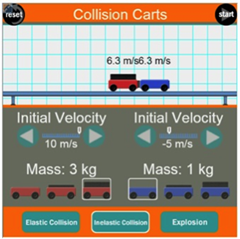 Inelastic Collisions - Activity Description
Inelastic Collisions - Activity Description
Resource:
Physics Interactives - Collision Carts
Inelastic Collisions Activity
Grade Level: High School
Description:
Students explore collision principles using our Collision Carts simulation. They collect and analyze data in order to discover mathematical relationships between the before- and after-collision momentum of individual carts and of a system of two carts. They make a claim regarding momentum conservation and support the claim using evidence and reasoning. This activity is very similar to the
Elastic Collisions activity; both use the Collisions Carts Interactive and have very similar format.
Performance Expectation:
Force and Motion (HS-PS2-2): Use mathematical representations to support the claim that the total momentum of a system of objects is conserved when there is no net force on the system.
This activity aligns with the three dimensions of the Next Generation Science Standards in the manner described below:
| Force and Motion (HS-PS2.A.2): Momentum is defined for a particular frame of reference; it is the mass times the velocity of the object. |
Students use mass and velocity values reported in the simulation in order to calculate the momentum values of the colliding carts before and after the collision. |
| Force and Motion (HS-PS2.A.3): If a system interacts with objects outside itself, the total momentum of the system can change; however, any such change is balanced by changes in the momentum of objects outside the system. |
By analyzing the pre- and post-collision momentum values of the two colliding carts, students will recognize that the momentum lost by one cart is equal to the momentum gained by the other cart. |
| Systems and System Models: When investigating or describing a system, the boundaries and initial conditions of the system need to be defined and their inputs and outputs analyzed and described using models. |
The Inelastic Collision activity leads students to the conclusion that when the colliding objects in a collision are viewed as a system, it is the combined momentum of both objects - that is, of the system - that is conserved. The total system momentum is the same before and after the collision. |
| Developing and Using Models: Develop and use a model based on evidence to illustrate the relationships between systems or between components of a system. |
This activity guides students to an understanding that collision occurring within an isolated system are characterized by the conservation of total system momentum. One object within the system - for instance, the red cart - will lose momentum while the other object - the blue cart - will gain that momentum. The momentum lost by one object is gained by the other object such that the total amount of momentum within the system is conserved. |
| Analyzing and Interpreting Data: Analyze data using computational models in order to make valid and reliable scientific claims. |
After collecting mass and velocity values for individual carts before and after the simulated collision, students calculate the momentum of individual carts and of the system of two carts. Students then inspect and analyze the data in order to make a claim regarding the mathematical relationships. Students are asked to make reference to their data in order to support their claim. |
| Using Mathematics and Computational Thinking: Use mathematical representations of phenomena to describe and/or support claims and/or explanations.
|
The Inelastic Collisions activity is reliant upon students computing momentum values for several trials and using the computed values in order to make a claim regarding the conservation of system momentum. The activity is math-intensive and students draw their conclusions from the computed values. |
Associated Reading from The Physics Classroom Tutorial:
Other Supporting Pages at The Physics Classroom:
Search the NGSS Corner
Maybe you're looking for something really specific that pertains to a desired topic and emphasizes one or more of the listed NGSS dimensions. Why not try a search of this section of our website? Simply select from one or more of the pull-down menus and click Search. This page will reload and a collection of possibilities will be displayed in this section of the page and sorted by relevancy.